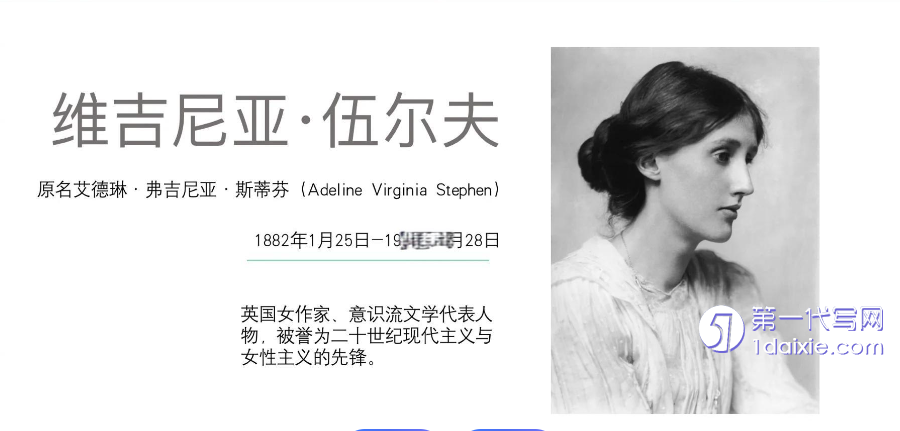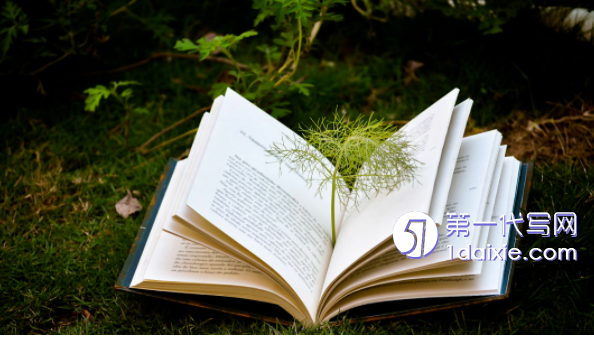本文是一篇英语毕业论文,本研究揭示《海浪》不仅是意识流小说的巅峰之作,更是现代性别诗学的实验场域。通过双性同体理论框架,论文重构了伍尔夫研究中的形式-内容二元对立,证明其叙事革命与性别政治存在深刻的同构性。
1.Introduction
1.1 Virginia Woolf and The Waves
Virginia Woolf(1882-1941),a central figure of British modernism,revolutionized narrative form through her stream-of-consciousness technique andphilosophical inquiries into human subjectivity.As a member of the BloomsburyGroup,she embodied the intersection of avant-garde aesthetics and feminist thought.Critics such as Hermione Lee note that Woolf’s oeuvre“collapses boundariesbetween fiction and philosophy,”(Lee,1996:347)while her essays,ARoom of One’sOwn(1929)established her as a pioneering theorist of gender politics.
Her concept of“androgynous writing”articulated as a fusion of masculinerationality and feminine intuition—challenged patriarchal literary traditions,arguingthat“it is fatal for anyone who writes to think of their sex”(Woolf,1989:72).Thisvision materialized in experimental novels like Orlando(1928),Mrs.Dalloway(1925),and The Waves(1931),each deconstructing fixed notions of identity.
Woolf’s sensitivity to gender oppression stemmed from lived experience.Borninto the intellectual Stephen family,her father Leslie Stephen was a Victorian man ofletters,her mother Julia Jackson a Pre-Raphaelite muse.Her childhood was markedby contradictions:privilege coexisted with psychological violence.The prematuredeaths of her mother(1895),stepsister Stella(1897),brother Thoby(1906),and father(1904)plunged her into cyclical grief,compounded by sexual abuse from herhalf-brother Gerald Duckworth,as documented in her memoir Moments of Being(1976).These traumas,as Lyndall Gordon argues,forged her“double consciousness”of societal hierarchies and female marginalization(Gordon,1986).The BloomsburyGroup,which she joined in 1905,provided intellectual refuge;here,she engaged withthinkers like E.M.Forster and Lytton Strachey,cultivating a subversive aesthetic thatmerged formal innovation with feminist critique.

1.2 Literature Review
Since there are relatively few studies on androgynous consciousness in TheWaves,the literature review mainly focuses on The Waves.The research gap will bepresented at the end of this part.As The Waves is a piece of foreign literature,considering its lag of time in introducing the translated one into China,the foreign studies will be reviewed in the first section,followed by domestic research in thesecond section.From the literature review,the analysis of previous studies from bothsides will walk readers through the major critical opinions on The Waves,so thataudiences can have a more comprehensive and in-depth understanding of the gapbetween this thesis and former research on The Waves.In the end,the last section willconclude the summary and comment on all research that has been mentioned.Andmost importantly,it emphasizes the research gap again and leads to the theoreticalframework.
1.2.1 Foreign Studies
Upon its publication in 1931,The Waves became a lightning rod for debatesabout modernist experimentation.It’s a bold experiment that Woolf made winning herthe reputation of a pioneering modernist writer.In the early stage,scholars mainlyfocused on its innovative narrative innovation from the perspective of modernism,andrelated it to stream of consciousness.Nowadays,research on The Waves have becomeincreasingly comprehensive.Studies have been carried out analyzing The Waves fromdifferent perspectives,such as post-colonial,and imperial reading,through feministtheory and in the light of psychology and philosophy.Due to the sheer number ofperspectives of foreign studies,which have varied over the years,this review willmainly focus on research on narrative techniques,language and genre,gender andidentity.
2.Androgynous Subjectivity:Characters Analysis
2.1 Bernard and Naville:Chaos and Order
In The Waves,Bernard and Neville emerge as dialectical embodiments ofneo-androgynous vision:two poles of consciousness oscillating between chaos andorder,fluidity and structure.Their dynamic interplay transcends gendered binaries,revealing androgyny not as a static synthesis but as a living tension betweenpsychological forces.While Bernard’s protean openness dissolves boundaries,Neville’s taxonomic conscientiousness constructs them;their oppositional trajectoriesultimately converge in Woolf’s modernist interrogation of identity as a degenderedcontinuum.
2.1.1 Bernard:The Openness-driven Storyteller
Virginia Woolf’s The Waves positions Bernard as a paradigm of neo-androgyny,transcending gendered binaries through a fluid integration of personality traits,openness to experience,neuroticism,and extraversion,which defy categorization.Hisidentity,rooted in storytelling and psychological multiplicity,exemplifies Woolf’smodernist vision of androgyny as a holistic,gender-neutral spectrum of humanconsciousness.
2.2 Jinny and Susan:Sensuality and Maternity
Jinny and Susan embody Woolf’s radical decoupling of psychological traits fromgendered essentialism,reframing sensuality and maternity not as biologicallydetermined roles but as degendered manifestations of personality.While Jinny’skinetic vitality and Susan’s maternal devotion superficially align with traditionalfemininity,Woolf subverts these tropes by grounding them in universal psychologicaldimensions—extraversion and conscientiousness—that transcend biologicaldeterminism.Their contrasting trajectories expose the artificiality of gender binaries,positioning desire and care as human rather than feminine imperatives.
2.2.1 Jinny:The Degendering of Sensuality
Jinny’s physical vitality and social energy are rooted in sensory experience,notfemininity.Her confidence transcends reductive tropes of the“seductress,”insteadreclaiming sensuality as a form of agential power.As Bullock observes,Jinny’smetaphors operate not as semantic substitutions but as rhythmic pulsations that mirrorthe semiotic chora,Kristeva’s pre-linguistic realm of bodily drives(Bullock,1989:90).Unlike Neville,who clings to symbolic order,Jinny inhabits the semiotic throughmovement.As we can see from Jinny’s soliloquy:I move,I dance;I never cease to move and to dance.I move like the leaf thatmoved in the hedge as a child and frightened me.I dance over these streaked,these impersonal,distempered walls with their yellow skirting as firelightdances over teapots.(Woolf,2015:18)
3.Androgynous Narrative:Time and Perspective...........................46
3.1 Woolf’s Early Temporal Experimentation................................47
3.2 Moments of Being:Androgyny as Temporal Epiphany............................49
3.3 Eyeless Writing:Androgyny as Decentered Writing................................54
4.Androgynous Aesthetics:Genre and Language.........................61
4.1 Genre Hybridity:Poetry,Prose,and Drama...........................61
4.2 Linguistic Androgyny:The“Little Language”Revolution......................65
5.Conclusion.........................................73
4.Androgynous Aesthetics:Genre and Language
4.1 Genre Hybridity:Poetry,Prose,and Drama
Virginia Woolf’s The Waves(1931)stands as a monumental achievement inmodernist literature through its radical fusion of poetic,dramatic,and novelisticelements,a formal revolution that materializes her feminist vision of artisticandrogyny.As Woolf declared in her diary,this experimental work constitutes“not anovel nor a play but a play-poem”(Woolf,1980:203),deliberately destabilizingpatriarchal genre hierarchies that had long associated novels with masculinerationality and poetry with feminine sensibility.Through its choric structure,musicalarchitectonics,and linguistic hybridity,The Waves transcends what Woolf criticized as“the petty categorizations that sterilize art”(Woolf,1927:207),creating a textualembodiment of her belief that“the androgynous mind is resonant,porous,andtransmits emotion without impediment”(Woolf,1989:102),creating a textual spacewhere gender binaries dissolve through formal innovation.
Late Victorian literature enforced rigid genre distinctions mirroring societalgender roles.Novels,associated with linear plots and empirical realism,were codedmasculine,while poetry’s lyricism was relegated to the feminine sphere.Woolf’s1927 essay“The Narrow Bridge of Art”explicitly critiques this binary,arguing thatthe novel had become“petrified by its fact-recording function”(Woolf,1927:205),while poetry remained“too pure to bear human complexity”(Woolf,1927:207).TheWaves obliterates these divisions through nine italicized interludes of poetic naturedescriptions alternating with nine episodes of dramatic soliloquies,a structure PanJian describes as“a three-dimensional textual space where genres cross-pollinate”(Pan,2007:68).

5.Conclusion
This thesis has undertaken a comprehensive exploration of androgyny in VirginiaWoolf’s The Waves.Through a detailed analysis of the novel’s characters,narrativetechniques,and genre and language,we have identified several key findings that shedlight on the openness of androgyny and its significance in Woolf’s work.
From the perspective of character construction,Woolf portrays androgyny not asa mechanical blend of masculine/feminine traits but as a fluid integration ofpersonality dimensions(Big Five traits)that exist independently of gender.It’s aninvitation for all human beings to live without the burden of gender or sex,just asVirginia Woolf presents a rich tapestry of six main characters—Bernard,Neville,Louis,Susan,Jinny,and Rhoda—each embodying Big Five traits,the non-innate,butacquired personalities.Woolf’s textual innovations—in narrative techniques andlinguistic experimentation—constitute the most complex and courageous attempt ofher era to envision such a horizon.As Woolf fractures syntax and dissolves narrativeauthority,she invites us to perceive gender not as a cage but as a kaleidoscope—aprismatic multiplicity awaiting activation.
reference(omitted)
